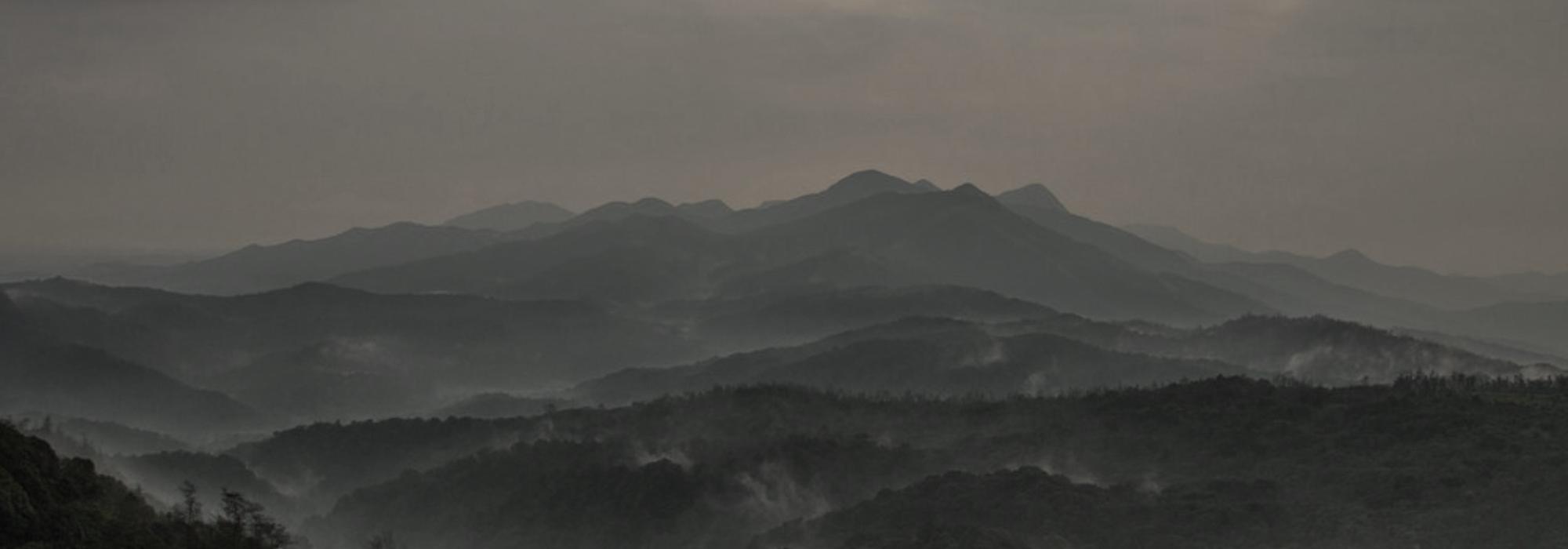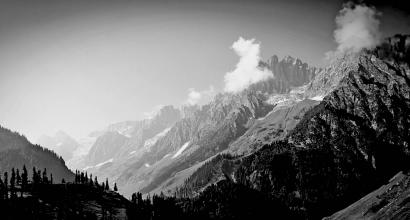Story 24
31. The king Trivikramasena carried he corpse for the twenty-fourth time on his shoulders and left. The vetāla started narrating another story –
There lived a māṇḍalika by name Dharma in Dakṣiṇāpatha. He had a wife called Candramatī and a daughter named Lāvaṇyavatī. As his relatives captured his kingdom, he escaped with his wife and daughter to his father-in-law’s house. He took all the jewellery and valuables along with him. On the way, he came across the Vindhyā forest. There, he encountered a group of bhillas. Dharma’s wife and daughter hid behind the bushes. The king picked up his sword and shield and killed many bhillas. Finally, he got captivated by them. As per the command of their master, the bhillas executed him. The women came to know of this ghastly deed, went ahead in the forest and sat below an Ashoka tree, crying.
Meanwhile, Caṇḍasiṃha and his son, who were residents of the province, were in the forest on a hunt. They spotted the footprints of the women. Both looked beautiful – one was smaller and the other larger. Siṃhaparākrama, the son, told his father, “I will marry this girl of short steps; you marry the girl with long strides.” The father said, “What is this you’re speaking! It was not too long before that your mother breathed her last. Having lost such a devoted and wonderful wife, will I desire for another wife?” The son said, “Without a wife, a house is not a home! You must remarry at any cost. I insist![1]” And thus, without any option, he had to agree. Then they went up to the women and asked them who they were and where they came from. Having realised that they had no menfolk at home, they offered words of solace. Father and son each had one woman sit with them on their horse and rode into town. The son Siṃhaparākrama married the queen Candravatī who had small feet while the father Caṇḍasiṃha married the girl Lāvaṇyavatī who had long legs. (Their assessment that the one with short steps was the younger one and the one with long strides was the older one proved to be just the opposite.) As a result mother and daughter married son and father. In due course, both had sons and daughters as well as granddaughters.
Having narrated the tale, the vetāla said, “Mahārāja! The children born to the mother and daughter – how are they related to each other? If you know the answer yet remain silent, your head will break into pieces!” As hard as he might rack his brains, the king found no solution to this puzzle. Therefore, he walked forward without uttering a word. Seeing this the vetāla thought, “Mahārāja cannot give an answer to my question; therefore he walks on silently. He is endowed with sattva; it is not possible to dupe him; but that bhikṣu will not leave it at this; therefore, I will trick that evil-souled one by means of stratagem and I will ensure that the king gains the siddhi that will come soon.” Then he told the king, “Mahārāja! Despite troubling you this long, you never grew weary; I admire your fortitude and courage. Therefore I will tell you something that will bode well for you, listen; I will now come out of that corpse. Carry it and offer it to the bhikṣu; he wants to invoke me into it and offer your head as a sacrifice for worship. This is his intention. And so, he will ask you to bow down. When he tells you that, you must say at once: ‘Please show me how one should bow down!’ When he demonstrates how one bows down, immediately take out your sword and behead him. Then, you will be the recipient of the wealth and siddhi of the vidyādhara whom he desires to invoke. Give the bhikṣu’s life as offering and obtain those [i.e., wealth and superpowers]. If not, he will offer your severed head. It is for that reason I became an obstacle in your path all this time. May you attain all success! Go!” Saying this, he went away. The king gladly took the corpse on his shoulder all the way to the Banyan tree.
Story 25
32. The bhikṣu sat looking at the road. When he saw the king carrying the corpse, he was delighted and got up at once. He said, “Mahārāja! You have showered me with your grace. Who indeed will toil thus for the welfare of others!” Having thus uttered words of praise, he helped the king bring down the corpse on to the ground. Then he bathed the cadaver, decorated it with flowers, and placed it at the centre of the maṇḍala. He rubbed his body with sacred ash. Wearing a yajñopavīta made from hairs, he donned the clothes worn by the corpse. Having invoked the vetāla in the corpse, he began his worship. He offered arghya using a skull. Human eyes were used as dhūpa (incense) and meat was offered as naivedya. He instructed the king who was nearby, “O king! Please prostrate before him; he will bestow upon you everything you desire!” The king replied, “Svāmin! I’ve never done this before; if you demonstrate to me how to do it, I’ll do the same!” As soon as the bhikṣu placed his head on the ground, the king slashed his throat with his sword and killed him. He took out his heart-lotus and offered it to the vetāla. The pleased vetāla replied, “Now you shall get the position of the king of vidyādharas which the bhikṣu desired, you’ll get it once you finish enjoying the vast expanse of the earth. I’ve troubled you a lot; ask anything you want!” The king replied, “If you are propiated, what isn’t possible! But I only desire this, let this twenty-fifth story along with the other twenty-four stories you have narrated to me, gain fame; let them be worshipped!” The vetāla agreed and went back to the tree.
As soon as the vetāla vanished, Maheśvara appeared before him and said, “O great king! You had born as my aṃśa (part) before as Vikramāditya to kill all the rākṣasas who were born as mlecchas; now you are born like this; in near future you’ll become the king of vidyādharas and finally you shall attain me; take this sword called aparājita!” He was duly worshipped before he vanished.
Thus Trivikramasena accomplished his task which he had set out to do on the previous night and returned to Pratiṣṭhānapura by the dawn. As promised by Maheśvara he eventually became the king of vidyādharas and finally attained him.
The End of Vetāla-pañcaviṃśati
The current article is a translation of Prof. A R Krishnasastri’s Kannada classic Kathāmṛta along with additional segments added from the original Kathā-sarit-sāgara (of Soma-deva). Bṛhat-kathā-mañjarī (of Kṣemendra) and Bṛhat-kathā-śloka-saṃgraha (of Budha-svāmin) have also been referred to. The translation has been rendered by Raghavendra G S, Arjun Bharadwaj, Srishan Thirumalai, and Hari Ravikumar.
The original Kannada version of Kathāmṛta is available for free online reading. So are the other works of Prof. A R Krishnasastri at https://ark.sirinudi.org/
[1] The original has ‘ಇಲ್ಲದಿದ್ದರೆ ನನ್ನಾಣೆ’ which is untranslatable into English.










































